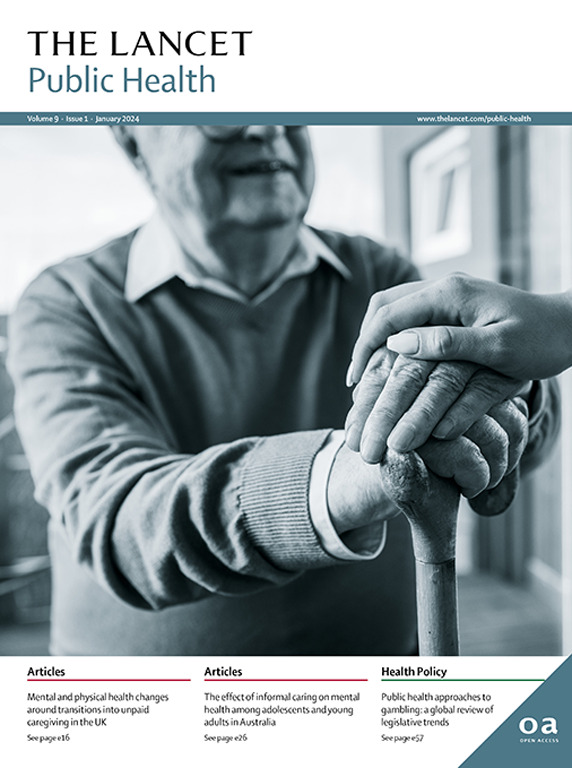Salt warning labels in the out-of-home food sector: online and real-world randomised controlled trials in the UK
IF 25.2
1区 医学
Q1 PUBLIC, ENVIRONMENTAL & OCCUPATIONAL HEALTH
引用次数: 0
Abstract
Background
High salt intake increases the risk of cardiovascular disease. The salt content of many commonly consumed foods in the out-of-home food sector (eg, restaurants) is excessive, but there are few policy options to address this problem. In this study, we evaluated an emerging policy approach—high salt warning labels on packaged food and resturant menus—for which, to date, there is little supporting evidence from randomised controlled trials.Methods
These randomised controlled trials (one online study and one trial conducted in a real-world setting) were conducted in the UK. For study 1, an online study, participants (stratified by age, sex, and education to be representative of the UK adult population) were eligible if they were a current UK resident, aged 18 years or older, fluent in English, purchased supermarket sandwiches and savoury snacks, and ate out at or ordered from restaurants at least monthly. Exclusion criteria included being pregnant or breastfeeding or having major dietary restrictions. Participants were randomly assigned (1:1:1:1:1) to one of four different salt warning label conditions or to a control condition (QR code). Participants assigned to each group completed three packaged food scenarios and three restaurant ordering scenarios, all online, followed by questionnaires about the labelling and their food choices. The primary outcome was the perceived message effectiveness of salt warning labels. In study 2, the inclusion criteria were similar, except that participants who ate an out-of-home meal at least once a month were recruited. Exclusion criteria were severe dietary allergies and veganism. As in study 1, participants were stratified by age, sex, and education. Participants were randomly assigned (block randomisation with block size ~50) to receive menus with or without salt warning labels, from which they purchased and consumed lunchtime meals in a real-world restaurant. Participants then completed questionnaires. Primary outcomes were perceived message effectiveness and salt awareness. In both studies, perceived message effectiveness was measured with adapted versions of the University of North Carolina Perceived Message Effectiveness Scale. Participants in both studies were paid and masked to the study aims. Study 2 is registered with ClinicalTrials.gov (NCT06458270) and is complete.Findings
In study 1, 2549 participants were randomly assigned to one of four salt warning label groups (red triangle, n=512; black triangle, n=512; red octagon, n=509; and black octagon, n=510) or to the control group (n=506), with data collected between Feb 20, 2024, and April 2, 2024. 158 participants were excluded from analysis, resulting in a final analytic sample of 2391 (1205 [50%] female, 1181 [49%] male, and five [<1%] preferred not to say). All salt warning labels were perceived as significantly more effective at discouraging salt intake than the control, with mean perceived message effectiveness differences of 1·23 (95% CI 1·12–1·34; p <0·0001) for packaged food scenarios and 1·22 (95% CI 1·11–1·33; p <0·0001) for menu scenarios. In study 2, 465 eligible participants were randomly assigned to menus with red triangle salt warning labels next to high-salt items (n=240) or to the restaurant's standard menu (control group; n=225), with data collected between June 5, 2024, and Sept 14, 2024. Full data from 11 participants were excluded from analysis, resulting in a final analytic sample of 454 (246 [54%] female, 203 [45%] male, and five [<1%] missing). The labelled menu was rated as significantly more effective than the control menu in terms of perceived message effectiveness, with a mean difference of 1·00 (95% CI 0·79–1·18; p<0·0001). Participants assigned to the labelled menu condition were significantly more likely to think about the salt content of the meals when ordering than were participants assigned to the standard menu (odds ratio 19·50, 95% CI 8·24–46·16; p<0·0001).Interpretation
Salt warning labels on restaurant menus are a promising policy option to discourage high salt intake in the out-of-home food sector. Further real-world studies are needed to optimise potential policy to reduce actual salt intake.Funding
National Institute for Health and Care Research Oxford Health Biomedical Research Centre and European Research Council.户外食品行业的盐警告标签:英国在线和现实世界的随机对照试验
背景:高盐摄入量会增加患心血管疾病的风险。在户外食品部门(例如,餐馆)中,许多经常食用的食品的含盐量过高,但解决这一问题的政策选择很少。在这项研究中,我们评估了一种新兴的政策方法——在包装食品和餐馆菜单上贴上高盐警告标签——迄今为止,几乎没有来自随机对照试验的支持证据。这些随机对照试验(一项在线研究和一项在现实环境中进行的试验)在英国进行。研究1是一项在线研究,参与者(按年龄、性别和教育程度分层,代表英国成年人口)符合条件,前提是他们目前是英国居民,年龄在18岁或以上,英语流利,购买超市三明治和美味小吃,至少每月在餐馆吃饭或点餐。排除标准包括怀孕或哺乳或有重大饮食限制。参与者被随机分配(1:1:1:1:1)到四种不同的盐警告标签条件之一或控制条件(QR码)。被分配到每一组的参与者完成了三个包装食品场景和三个餐厅点餐场景,所有这些都是在线的,然后是关于标签和食物选择的问卷调查。主要结果是盐警告标签的感知信息有效性。在研究2中,纳入标准相似,除了每月至少吃一次户外餐的参与者被招募。排除标准是严重的饮食过敏和素食主义。与研究1一样,参与者按年龄、性别和教育程度分层。参与者被随机分配(分组随机,分组大小约为50),收到有或没有盐警告标签的菜单,他们在现实世界的餐馆购买和食用午餐。然后参与者完成问卷调查。主要结果是感知信息有效性和盐意识。在这两项研究中,感知信息有效性是用北卡罗来纳大学感知信息有效性量表的改编版本来测量的。两项研究的参与者都得到了报酬,并对研究目标进行了隐瞒。研究2已在ClinicalTrials.gov (NCT06458270)注册完成。在研究中,1249名参与者被随机分配到四个盐警告标签组(红色三角形,n=512;黑色三角形,n=512;红色八边形,n=509;和黑色八角形(n= 510)或对照组(n=506),数据收集时间为2024年2月20日至2024年4月2日。158名参与者被排除在分析之外,最终的分析样本为2391人(1205名[50%]女性,1181名[49%]男性,5名[1%]不愿透露)。所有盐警告标签在阻止盐摄入方面被认为比对照组更有效,平均感知信息有效性差异为1.23 (95% CI 1.12 - 1.34;p < 0.0001)和1.22 (95% CI 1.11 - 1.33;P < 0.0001)用于菜单场景。在研究2中,465名符合条件的参与者被随机分配到高盐食品旁边有红色三角盐警告标签的菜单(n=240)或餐馆的标准菜单(对照组;n=225),数据收集于2024年6月5日至2024年9月14日之间。11名参与者的全部数据被排除在分析之外,最终的分析样本为454人(女性246人[54%],男性203人[45%],缺失5人[1%])。标签菜单在感知信息有效性方面被评为比对照菜单更有效,平均差异为1.00 (95% CI 0.79 - 1.18;术;0·0001)。被分配到标签菜单条件下的参与者在点餐时比被分配到标准菜单条件下的参与者更有可能考虑饭菜的含盐量(优势比19.50,95% CI 8.24 - 46.16;术;0·0001)。餐馆菜单上的盐警告标签是一项有希望的政策选择,以阻止户外食品部门的高盐摄入量。需要进一步的实际研究来优化潜在的减少实际盐摄入量的政策。资助国家健康和护理研究所牛津健康生物医学研究中心和欧洲研究委员会。
本文章由计算机程序翻译,如有差异,请以英文原文为准。
求助全文
约1分钟内获得全文
求助全文
来源期刊

Lancet Public Health
Medicine-Public Health, Environmental and Occupational Health
CiteScore
55.60
自引率
0.80%
发文量
305
审稿时长
8 weeks
期刊介绍:
The Lancet Public Health is committed to tackling the most pressing issues across all aspects of public health. We have a strong commitment to using science to improve health equity and social justice. In line with the values and vision of The Lancet, we take a broad and inclusive approach to public health and are interested in interdisciplinary research.
We publish a range of content types that can advance public health policies and outcomes. These include Articles, Review, Comment, and Correspondence. Learn more about the types of papers we publish.
 求助内容:
求助内容: 应助结果提醒方式:
应助结果提醒方式:


